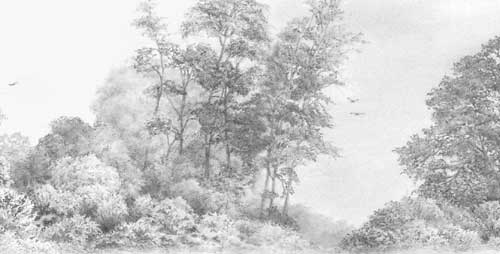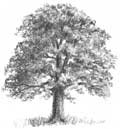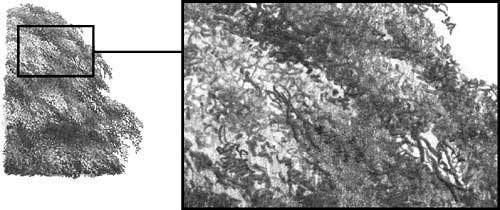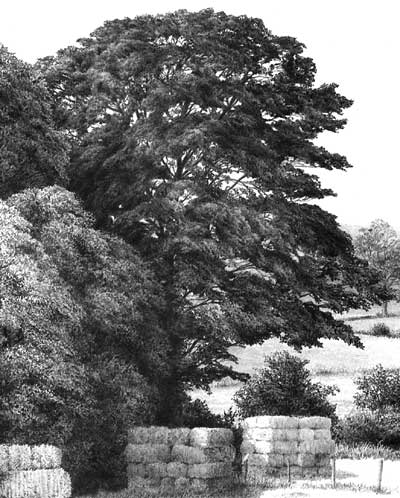
Drawing trees or shrubs really has to begin with observation. I’m forever looking at trees and trying to work out in my mind how I would draw them.
You really need that information in your mind – the layers of foliage and how they stack one over the other; the side and front elevations of blocks of foliage; the holes through which you can see sky; the relative sizes and appearances of the internal structure, and so on.
With a good three-dimensional idea of structure in your mind you can now begin drawing trees with confidence. I tend to “talk” to myself as I draw, as if explaining it to someone else. So I’ll be drawing a layer of foliage whilst telling myself that it will contain the cast shadow of the layer of leaves above; that this is at the edge of the tree and will show more sky; that I need more depth here so the appearance of a section of trunk would aid understanding.
Or of course you can take Diane Wright’s method – which is to draw intuitively and brilliantly and capture the absolute essence… 🙂
www.DianeWrightFineArt.com/drawing-trees
When drawing far-away trees or trees in mist I try to draw correctly first time. But if that doesn’t work, I will often draw stronger than I need to, which gives me more control over relative contrasts – then I gradually fade the area with Blu-Tack until I reach the desired overall tonal structure. Sometimes I then redraw and fade again – repeatedly at times – each time bringing the drawing a little more towards the reality I’m trying to depict.

Background trees in Weimaraner study “Vanished!” © Mike Sibley 2004
When drawing midground or background shrubs and trees bear these points in mind:
- Be aware that it has a real sense of roundness. It is a three-dimensional rounded form and should conform to the lighting present.
- Is it perhaps a little too tidy? Even if it is a shrub clipped into a shape you can adapt it to suit your own requirements. Imagine looking at the bush in real life and asking yourself what, at that distance, are the major features that make it what it is.
- One feature might be the dense shadow it casts beneath itself on the ground. If your reference bush is too low, lift it a bit. That shadow will properly ground the bush.
- If you show dark areas within your bush that are assumed to be the shadows in the depths between foliage layers, be aware that there should be two distinct tones – a dense tone to represent the inner depths of the shrub, and a lighter shadow cast on that layer by the one above.
- Another important feature to consider is the appearance of the leaves at the extremities (around the outside of the tree or bush). You can make excellent use of these by using them as visual clues to signal to the viewer’s eye the presence of an overall leafy appearance, and an indication of leaf size and possibly even the species.

But it all begins with observation. As an exercise, try sketching a tree in real life but really small – no bigger than 2″ x 3″ (or larger but using with a very soft, blunt pencil). This will force you to abandon detail and concentrate only on what is important.
You will find more information on drawing trees in my website’s Drawing Trees tutorial and a complete chapter in my “Drawing from Line to Life” book.

Drawing a Tree example from ‘Drawing from Line to Life’

A tree study from Bearded Collie drawing Done Balin’